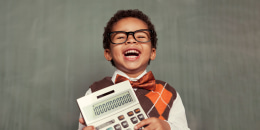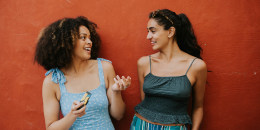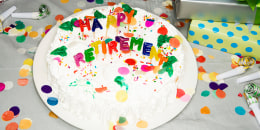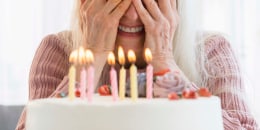You might not have seen it, but you have an aura — just ask professional aura reader, Megan Firester.
Seeing auras comes naturally to Firester, and since she was a child, she has seen a haze of colored light around people.
“It’s a little different than my physical eyes because I know the difference. But it looks the same to me,” she tells TODAY.com. “It’s like, there’s not a moment you remember when you learned how to smell. Seeing auras is like that for me.”

As she got older, Firester saw the practical application of her skill: People with green auras were “smart” and could answer her questions; people with purple auras had a disposition like her mom’s.
While working as an elementary school teacher, she noticed students with the same color auras processed learning similarly. When dating, she “always” went after the assertive red auras: “I’m a little more passive. I don’t mind someone saying, ‘This is where we’re going out to dinner.'”
Firester says her ability to read auras stems from her open “third eye,” a mystical term for the seat of intuition located between a person’s eyes. Her aura vision could also be a form of synaesthesia, as a 2004 University College London study suggested.
Regardless of its origins, she has used her perception to navigate socializing and share her learnings. Now, on her Instagram page and podcast, Firester tries to teach people how to tune into their auras and explain why they should. Ultimately, Firester says, aura reading is an exercise in strengthening intuition.
“If you get a good vibe from somebody or if you get a bad vibe from somebody, it’s real,” she says.
Below, Firester answers all our questions about auras.
What is an aura?
Firester says “seeing auras” is a spiritual phrase for something you’re probably already doing, all the time: Picking up on people’s vibes.
“Auras are the vibrational waves you naturally give out. We pick up on these all the time. You just have a feeling about whether someone is trustworthy or someone feels like they’re on edge. If you dive deeper and pay more attention to it, you are going to start getting colors with it.”
Another term for an aura is an “energy signature” — and everyone has one, the same way we all have personalities and thumbprints. “They are all individual,” Firester says of auras.
What does each aura color mean?
Firester perceives about nine main aura colors and says most people have a combination of two. Each color is associated with specific characteristics.
In her categorization, indigo, purple, blue and turquoise are empaths, and red, yellow and greens are logicians.
Here are the traits associated with each aura color:
- Red: “Direct, assertive and take-charge leaders who have good natural instincts about others.”
- Blue: “Naturally empathic and sensitive people who are compassionate and thoughtful givers.”
- Yellow: "Organized and curious multi-taskers who seek constant self-improvement and love direct, honest communication."
- Purple: “Creative, intuitive rebels who crave change and artistic outlets.”
- Green: “Logical, intellectual, detail-oriented thinkers who crave passionate projects which promote challenging self growth.”
- Turquoise: “Compassionate, old soul, quiet healers who mirror to others their own selves. “
- Indigo: “Absorbing empaths who have the ability to mind-read as well as non-verbally communicate in an attempt to heal others.”
- Pink: “Optimistic, pure and loving innocent energies who tend to be brilliant manifestors and hopeless romantics.”
- Orange: “Focused and energetic people who enjoy inspiring others by way of taking the most innovative road wherever they go.”
Firester has also, on rare occasion, seen people with "rainbow" auras.
Is my aura always the same color, or does it change?
“Your core aura doesn’t change,” Firester says. “But we live life and that comes with traumas, societal expectations and those all impact your aura color.”
As a result, Firester says we “rebalance” our auras, maybe “pushing one color to the front” and “hiding the other.”
“When it does change, you’re hiding a part of yourself or doing something I call wearing an inauthentic color. You don’t feel like you can live as yourself,” she says.
That means you're stuck with your colors — but Firester says that's a reason to celebrate. During readings, she says people often experience relief when they understand their aura.
“Auras are a kind of self realization. People feel validated,” she says.
How can I see my aura?
Of course, everyone wants to see the mythic aura. Firester has a few tricks — but she cautions that seeing auras is a “muscle,” and it really does “take time to hone.”
Think about your favorite color
Firester says children can often see auras easily, and their auras are also brighter. So, when thinking back to your own, return to your youth.
“Think about what your favorite color was when you were a kid. Your aura is usually that color,” she says.
Take a video of yourself
“This really does work,” Firester says. “Put yourself in front of a white background, put your camera on record and put yourself in a meditative state. Breathe and close your eyes. Then watch the video back or send it to an intuitive friend and ask what color you see.”
Team up with a friend
Place a friend in front of a blank wall.
"Let your eyes defocus for a while and see if you see an impression of a color,” she says.
Trust your gut
Firester says the “easiest way” is to trust your “first instinct.” Ask, “What color does this person remind me of?”
“You can learn to follow the vibes: Pay attention to what you see about someone and follow it back into a category of color,” she says.
What color auras do TODAY's anchors have?
For a practical application of aura colors in action, Firester turned to TODAY.
She wasn’t surprised to see so much purple around the TODAY anchors — “they love the spotlight," she says.
Hoda Kotb is “red, blue and purple,” she says.
“They’re good at everything," Firester says. "As a red, she’s a leader and protective, watching out for the little guy. As a purple, she loves the spotlight. Blue is where she gets her caring nature and good heart.”
Al Roker is “green, purple and blue,” she says. “Green is everything scientific. He’s smart and quick. With purple, he feels like he’s 100 percent himself when he walks anywhere. He knows himself. He feels secure."
Sheinelle Jones is “purple and blue,” making her an artistic performer with a healer’s heart. Craig Melvin is “green and blue,” meaning he may be logical, but he’s equally empathetic.
Both Dylan Dreyer and Jenna Bush Hager are “blue and yellow,” she says, making them "perfectionists, because they believe in what they are trying to do in a way that makes other people proud."









